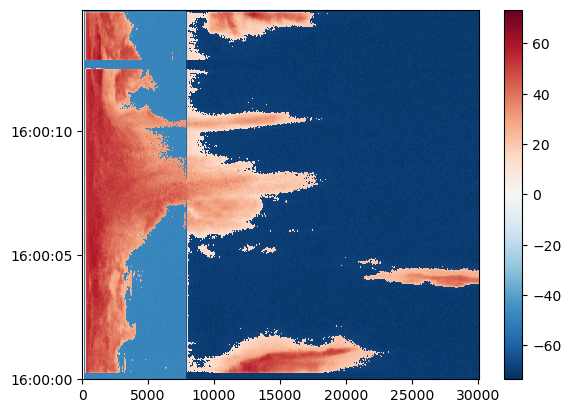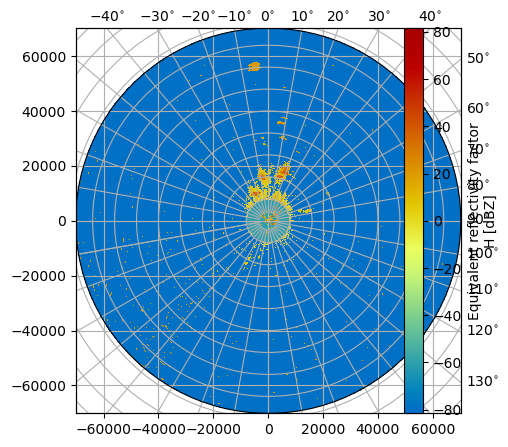xradar furuno backend#
In this example, we read scn/scnx (furuno) data files using the xradar furuno xarray backend.
[1]:
import glob
import gzip
import io
import wradlib as wrl
import warnings
warnings.filterwarnings("ignore")
import matplotlib.pyplot as plt
import numpy as np
import xradar as xd
import datatree as xt
import xarray as xr
try:
get_ipython().run_line_magic("matplotlib inline")
except:
plt.ion()
Load furuno scn Data#
Data provided by University of Graz, Austria.
[2]:
fpath = "furuno/0080_20210730_160000_01_02.scn.gz"
f = wrl.util.get_wradlib_data_file(fpath)
vol = xd.io.open_furuno_datatree(f, reindex_angle=False)
Downloading file 'furuno/0080_20210730_160000_01_02.scn.gz' from 'https://github.com/wradlib/wradlib-data/raw/pooch/data/furuno/0080_20210730_160000_01_02.scn.gz' to '/home/runner/work/wradlib/wradlib/wradlib-data'.
Inspect RadarVolume#
[3]:
display(vol)
<xarray.DatasetView>
Dimensions: ()
Data variables:
volume_number int64 0
platform_type <U5 'fixed'
instrument_type <U5 'radar'
time_coverage_start <U20 '2021-07-30T16:00:00Z'
time_coverage_end <U20 '2021-07-30T16:00:14Z'
sweep_mode <U20 'azimuth_surveillance'
longitude float64 15.45
altitude float64 407.9
latitude float64 47.08
Attributes:
Conventions: None
version: None
title: None
institution: None
references: None
source: None
history: None
comment: im/exported using xradar
instrument_name: NoneInspect root group#
The sweep dimension contains the number of scans in this radar volume. Further the dataset consists of variables (location coordinates, time_coverage) and attributes (Conventions, metadata).
[4]:
vol.root
[4]:
<xarray.DatasetView>
Dimensions: ()
Data variables:
volume_number int64 0
platform_type <U5 'fixed'
instrument_type <U5 'radar'
time_coverage_start <U20 '2021-07-30T16:00:00Z'
time_coverage_end <U20 '2021-07-30T16:00:14Z'
sweep_mode <U20 'azimuth_surveillance'
longitude float64 15.45
altitude float64 407.9
latitude float64 47.08
Attributes:
Conventions: None
version: None
title: None
institution: None
references: None
source: None
history: None
comment: im/exported using xradar
instrument_name: NoneInspect sweep group(s)#
The sweep-groups can be accessed via their respective keys. The dimensions consist of range and time with added coordinates azimuth, elevation, range and time. There will be variables like radar moments (DBZH etc.) and sweep-dependend metadata (like fixed_angle, sweep_mode etc.).
[5]:
display(vol["sweep_0"])
<xarray.DatasetView>
Dimensions: (azimuth: 1376, range: 602)
Coordinates:
elevation (azimuth) float32 ...
* range (range) float32 25.0 75.0 125.0 ... 3.002e+04 3.008e+04
time (azimuth) datetime64[ns] 2021-07-30T16:00:06.277723500...
sweep_mode <U20 ...
longitude float64 ...
latitude float64 ...
altitude float64 ...
* azimuth (azimuth) float32 0.21 0.47 0.74 ... 359.4 359.7 359.9
Data variables: (12/13)
RATE (azimuth, range) float32 ...
DBZH (azimuth, range) float32 ...
VRADH (azimuth, range) float64 ...
ZDR (azimuth, range) float32 ...
KDP (azimuth, range) float32 ...
PHIDP (azimuth, range) float32 ...
... ...
WRADH (azimuth, range) float64 ...
QUAL (azimuth, range) uint16 ...
sweep_number int64 ...
prt_mode <U7 ...
follow_mode <U7 ...
sweep_fixed_angle float64 ...Georeferencing#
[6]:
swp = vol["sweep_0"].ds.copy()
swp = swp.assign_coords(sweep_mode=swp.sweep_mode)
swp = swp.wrl.georef.georeference()
Inspect radar moments#
The DataArrays can be accessed by key or by attribute. Each DataArray has dimensions and coordinates of it’s parent dataset.
[7]:
display(swp.DBZH)
<xarray.DataArray 'DBZH' (azimuth: 1376, range: 602)>
[828352 values with dtype=float32]
Coordinates: (12/15)
elevation (azimuth) float32 7.8 7.8 7.8 7.8 7.8 ... 7.8 7.8 7.8 7.8 7.8
* range (range) float32 25.0 75.0 125.0 ... 3.002e+04 3.008e+04
time (azimuth) datetime64[ns] 2021-07-30T16:00:06.277723500 ... 20...
sweep_mode <U20 'azimuth_surveillance'
longitude float64 15.45
latitude float64 47.08
... ...
y (azimuth, range) float32 24.77 74.3 ... 2.973e+04 2.978e+04
z (azimuth, range) float32 411.0 418.0 ... 4.535e+03 4.542e+03
gr (azimuth, range) float32 24.77 74.3 ... 2.973e+04 2.978e+04
rays (azimuth, range) float32 0.21 0.21 0.21 ... 359.9 359.9 359.9
bins (azimuth, range) float32 25.0 75.0 125.0 ... 3.002e+04 3.008e+04
crs_wkt int64 0
Attributes:
long_name: Equivalent reflectivity factor H
units: dBZ
standard_name: radar_equivalent_reflectivity_factor_hCreate simple plot#
Using xarray features a simple plot can be created like this. Note the sortby('time') method, which sorts the radials by time.
For more details on plotting radar data see under Visualization.
[8]:
swp.DBZH.sortby("time").plot(x="range", y="time", add_labels=False)
[8]:
<matplotlib.collections.QuadMesh at 0x7f17c9b6ccd0>

[9]:
fig = plt.figure(figsize=(5, 5))
pm = swp.DBZH.wrl.vis.plot(crs={"latmin": 3e3}, fig=fig)

Use xr.open_dataset to retrieve explicit group#
Load furuno scnx Data#
Data provided by GFZ German Research Centre for Geosciences.
[10]:
fpath = "furuno/2006_20220324_000000_000.scnx.gz"
f = wrl.util.get_wradlib_data_file(fpath)
vol = xd.io.open_furuno_datatree(f, reindex_angle=False)
Downloading file 'furuno/2006_20220324_000000_000.scnx.gz' from 'https://github.com/wradlib/wradlib-data/raw/pooch/data/furuno/2006_20220324_000000_000.scnx.gz' to '/home/runner/work/wradlib/wradlib/wradlib-data'.
Inspect RadarVolume#
[11]:
display(vol)
<xarray.DatasetView>
Dimensions: ()
Data variables:
volume_number int64 0
platform_type <U5 'fixed'
instrument_type <U5 'radar'
time_coverage_start <U20 '2022-03-24T00:00:01Z'
time_coverage_end <U20 '2022-03-24T00:00:28Z'
sweep_mode <U20 'azimuth_surveillance'
longitude float64 13.24
altitude float64 38.0
latitude float64 53.55
Attributes:
Conventions: None
version: None
title: None
institution: None
references: None
source: None
history: None
comment: im/exported using xradar
instrument_name: NoneInspect root group#
The sweep dimension contains the number of scans in this radar volume. Further the dataset consists of variables (location coordinates, time_coverage) and attributes (Conventions, metadata).
[12]:
vol.root
[12]:
<xarray.DatasetView>
Dimensions: ()
Data variables:
volume_number int64 0
platform_type <U5 'fixed'
instrument_type <U5 'radar'
time_coverage_start <U20 '2022-03-24T00:00:01Z'
time_coverage_end <U20 '2022-03-24T00:00:28Z'
sweep_mode <U20 'azimuth_surveillance'
longitude float64 13.24
altitude float64 38.0
latitude float64 53.55
Attributes:
Conventions: None
version: None
title: None
institution: None
references: None
source: None
history: None
comment: im/exported using xradar
instrument_name: NoneInspect sweep group(s)#
The sweep-groups can be accessed via their respective keys. The dimensions consist of range and time with added coordinates azimuth, elevation, range and time. There will be variables like radar moments (DBZH etc.) and sweep-dependend metadata (like fixed_angle, sweep_mode etc.).
[13]:
display(vol["sweep_0"])
<xarray.DatasetView>
Dimensions: (azimuth: 722, range: 936)
Coordinates:
elevation (azimuth) float32 ...
* range (range) float32 37.5 112.5 187.5 ... 7.009e+04 7.016e+04
time (azimuth) datetime64[ns] 2022-03-24T00:00:17.656439500...
sweep_mode <U20 ...
longitude float64 ...
latitude float64 ...
altitude float64 ...
* azimuth (azimuth) float32 0.19 0.68 1.16 ... 358.7 359.2 359.7
Data variables: (12/13)
RATE (azimuth, range) float32 ...
DBZH (azimuth, range) float32 ...
VRADH (azimuth, range) float64 ...
ZDR (azimuth, range) float32 ...
KDP (azimuth, range) float32 ...
PHIDP (azimuth, range) float32 ...
... ...
WRADH (azimuth, range) float64 ...
QUAL (azimuth, range) uint16 ...
sweep_number int64 ...
prt_mode <U7 ...
follow_mode <U7 ...
sweep_fixed_angle float64 ...Georeferencing#
[14]:
swp = vol["sweep_0"].ds.copy()
swp = swp.assign_coords(sweep_mode=swp.sweep_mode)
swp = swp.wrl.georef.georeference()
Inspect radar moments#
The DataArrays can be accessed by key or by attribute. Each DataArray has dimensions and coordinates of it’s parent dataset.
[15]:
display(swp.DBZH)
<xarray.DataArray 'DBZH' (azimuth: 722, range: 936)>
[675792 values with dtype=float32]
Coordinates: (12/15)
elevation (azimuth) float32 0.5 0.5 0.5 0.5 0.5 ... 0.5 0.5 0.5 0.5 0.5
* range (range) float32 37.5 112.5 187.5 ... 7.009e+04 7.016e+04
time (azimuth) datetime64[ns] 2022-03-24T00:00:17.656439500 ... 20...
sweep_mode <U20 'azimuth_surveillance'
longitude float64 13.24
latitude float64 53.55
... ...
y (azimuth, range) float32 37.5 112.5 ... 7.008e+04 7.015e+04
z (azimuth, range) float32 38.0 39.0 39.0 ... 937.0 939.0 940.0
gr (azimuth, range) float32 37.53 112.5 ... 7.008e+04 7.015e+04
rays (azimuth, range) float32 0.19 0.19 0.19 ... 359.7 359.7 359.7
bins (azimuth, range) float32 37.5 112.5 ... 7.009e+04 7.016e+04
crs_wkt int64 0
Attributes:
long_name: Equivalent reflectivity factor H
units: dBZ
standard_name: radar_equivalent_reflectivity_factor_hCreate simple plot#
Currently the data dynamic range is left as read from the file. That way the difference between shortpulse and longpulse can be clearly seen.
Using xarray features a simple plot can be created like this. Note the sortby('time') method, which sorts the radials by time.
For more details on plotting radar data see under Visualization.
[16]:
swp.DBZH.sortby("time").plot(x="range", y="time", add_labels=False)
[16]:
<matplotlib.collections.QuadMesh at 0x7f17c8ad3fd0>

[17]:
fig = plt.figure(figsize=(5, 5))
pm = swp.DBZH.wrl.vis.plot(crs={"latmin": 3e3}, fig=fig)

More Furuno loading mechanisms#
Use xr.open_dataset to retrieve explicit group#
[18]:
swp_b = xr.open_dataset(f, engine="furuno", backend_kwargs=dict(reindex_angle=False))
display(swp_b)
<xarray.Dataset>
Dimensions: (azimuth: 722, range: 936)
Coordinates:
elevation (azimuth) float32 ...
* range (range) float32 37.5 112.5 187.5 ... 7.009e+04 7.016e+04
time (azimuth) datetime64[ns] ...
sweep_mode <U20 ...
longitude float64 ...
latitude float64 ...
altitude float64 ...
* azimuth (azimuth) float32 0.19 0.68 1.16 ... 358.7 359.2 359.7
Data variables: (12/13)
RATE (azimuth, range) float32 ...
DBZH (azimuth, range) float32 ...
VRADH (azimuth, range) float64 ...
ZDR (azimuth, range) float32 ...
KDP (azimuth, range) float32 ...
PHIDP (azimuth, range) float32 ...
... ...
WRADH (azimuth, range) float64 ...
QUAL (azimuth, range) uint16 ...
sweep_number int64 ...
prt_mode <U7 ...
follow_mode <U7 ...
sweep_fixed_angle float64 ...